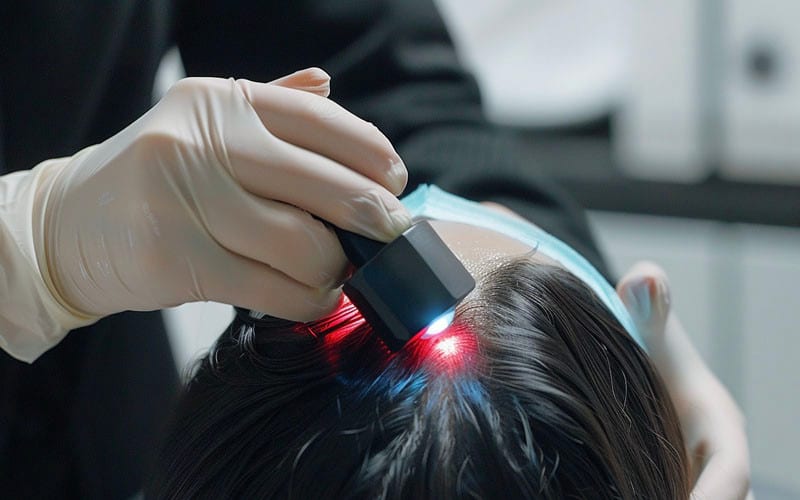Low-Level Laser Therapy (LLLT) has gained significant attention in recent years as a non-invasive treatment option for to stimulate overall hair regrowth. Many individuals experiencing hair loss turn to LLLT in hopes of restoring their hair density and confidence. However, a common question that arises is whether the effects of LLLT on hair regrowth are permanent.
Understanding the permanence of LLLT in hair regrowth is essential for individuals considering this treatment option. In this article, we delve into the mechanisms of LLLT, examine clinical evidence, explore factors influencing permanence, and provide insights from both patients and experts to shed light on the topic of LLLT’s long-term effectiveness in promoting hair regrowth.
Is LLLT Permanent?
LLLT treatment can lead to long-term hair regrowth for many individuals, but permanence may vary based on factors like treatment adherence and individual response. While some may experience sustained results, others may require ongoing maintenance sessions to maintain hair density.
Clinical evidence suggests that LLLT can stimulate hair follicles and promote regrowth, but the permanence of these effects may depend on various factors. Consulting with a healthcare professional can provide personalized insights into the potential permanence of LLLT to stimulate hair growth and reactivate the natural hair cycle.
Definition of Permanence in the Context of Medical Treatments

In the context of LLLT for hair regrowth, permanence refers to the lasting effectiveness of the treatment in stimulating hair follicles and promoting sustained hair growth over an extended period. It pertains to the ability of LLLT to produce durable outcomes, with hair regrowth maintained beyond the treatment period.
The permanence of LLLT effects on hair growth may vary among individuals and can be influenced by factors such as treatment adherence, genetic predisposition to hair loss, and underlying health conditions. Understanding the potential permanence of an LLLT laser cap in promoting hair regrowth is crucial for individuals considering this treatment option for long-term management of hair loss.
Explanation
Low-level laser light therapy has been shown to promote hair regrowth through its direct interaction with human scalp hair-mediated mechanisms. Male androgenetic alopecia, commonly known as male pattern baldness, is a condition characterized by progressive hair loss in men, typically occurring in a specific pattern on the scalp.
Low-level light therapy, also known as LLLT, is a non-invasive treatment method that utilizes low-level lasers or light-emitting diodes to stimulate cellular activity and promote various therapeutic effects in the body. Terminal hair density compared to vellus hair density is a key indicator used in assessing the effectiveness of low-level laser therapy for hair regrowth.
Hair shedding, a common concern for individuals experiencing hair loss, can be effectively managed with low-level laser therapy, which helps to reduce the rate of hair shedding and promotes healthier, stronger hair growth. Visible red light laser, a component of low-level laser therapy, penetrates the scalp to stimulate hair follicles, promoting hair regrowth and improving overall hair health.
Low-level laser therapy has been scientifically proven to promote hair growth by stimulating the hair follicles and increasing blood flow to the scalp, resulting in improved hair density and thickness over time. Surgical hair transplantation, a common procedure for addressing hair loss, involves transplanting healthy hair follicles from one part of the scalp to areas experiencing hair thinning or baldness, resulting in natural-looking and permanent hair regrowth.
Clinical Trials Using Low-Level Light Therapy
In clinical trials evaluating the efficacy of low-level laser therapy, participants are often randomized to receive either active treatment or a double-blind sham device, ensuring that neither the participants nor the researchers are aware of who is receiving the actual treatment, allowing for unbiased assessment of the therapy’s effectiveness.
Laser light, utilized in low-level laser therapy, emits specific wavelengths of light that penetrate the scalp to stimulate hair follicles, promoting hair regrowth and improving overall hair health. Thinning hair, a common concern for many individuals, can be effectively addressed with low-level laser therapy, which works to strengthen existing hair follicles and stimulate new hair growth, resulting in thicker and fuller-looking hair over time.
Mean terminal hair density refers to the average number of fully developed, mature hairs present in a specific area of the scalp, and it is a crucial measure used to assess the efficacy of low-level laser therapy in promoting hair regrowth.
Analysis of Factors Influencing the Longevity of Treatment Outcomes

Several factors influence the longevity of treatment outcomes in medical interventions, including:
Treatment Adherence: Consistent adherence to the recommended LLLT protocol, including the frequency and duration of treatment sessions, can significantly impact the long-term effectiveness of the therapy. Patients who adhere closely to the treatment regimen are more likely to experience sustained hair regrowth outcomes.
Individual Response: The response to LLLT treatment can vary among individuals due to factors such as genetic predisposition, underlying health conditions, and hair follicle sensitivity. Patients with a favorable response to LLLT are more likely to maintain hair regrowth over time compared to those who exhibit a less robust response.
Severity of Hair Loss: The severity of hair loss at the onset of LLLT treatment can influence the longevity of treatment outcomes. Patients with early-stage hair loss or minimal hair thinning may experience more pronounced and lasting results compared to those with advanced hair loss or extensive balding.
Concurrent Treatments: Combining LLLT with other hair loss therapies, such as topical medications or hair transplant surgery, can enhance treatment outcomes and contribute to long-term hair regrowth. The synergistic effects of multiple treatment modalities may lead to more sustained results than LLLT alone.
Lifestyle Factors: Lifestyle factors, including diet, exercise, stress levels, and smoking habits, can impact hair health and the efficacy of LLLT treatment. Patients who adopt healthy lifestyle habits and minimize factors that contribute to hair loss may experience better long-term outcomes with LLLT.
Comparison of Temporary Versus Permanent Solutions for Hair Loss
When comparing temporary versus permanent solutions for hair loss, it’s essential to consider various factors, including effectiveness, convenience, and long-term outcomes. Here’s a breakdown of both types of solutions:
Temporary Solutions
Topical Treatments: Products like minoxidil (Rogaine) and finasteride (Propecia) can help slow down hair loss and promote some degree of regrowth. However, these treatments require ongoing use to maintain results, and discontinuation may lead to hair loss resuming.
Hairpieces and Wigs: Wearing hairpieces or wigs offers an immediate solution to conceal hair loss. While they provide a quick fix, they do not address the underlying cause of hair loss and may require regular maintenance and replacement.
Hairstyling Techniques: Hairstyles such as comb-overs or strategic haircuts can temporarily disguise thinning areas and create the illusion of fuller hair. However, these methods are not permanent and may become less effective as hair loss progresses.
Permanent Solutions
Hair Transplant Surgery: Hair transplant procedures, such as follicular unit transplantation (FUT) or follicular unit extraction (FUE), permanently redistribute hair follicles from dense areas of the scalp to thinning or balding areas. The transplanted hair continues to grow naturally, providing a long-lasting solution to hair loss.
Low-Level Laser Therapy: LLLT stimulates hair follicles and promotes hair regrowth without surgery or invasive procedures. While LLLT may require ongoing maintenance sessions to sustain results, it offers a non-invasive and effective long-term solution for many individuals.
Scalp Micropigmentation (SMP): SMP involves tattooing tiny dots on the scalp to replicate the appearance of hair follicles. This technique can create the illusion of a fuller head of hair and provides a permanent solution for individuals seeking a low-maintenance option.
Overview of the importance of understanding the permanence of LLLT Low-Level Light Therapy treatments
Understanding the permanence of LLLT laser light therapy is essential for individuals seeking effective and long-lasting solutions for hair regrowth. LLLT offers a non-invasive approach to addressing hair loss by stimulating hair follicles and promoting new hair growth.
However, the permanence of LLLT effects can vary depending on several factors, including treatment adherence, individual response to therapy, and the underlying cause of hair loss.
One key factor influencing the permanence of LLLT is treatment adherence. Consistent and regular use of LLLT devices according to the prescribed treatment regimen is crucial for achieving optimal results. Patients who adhere diligently to the recommended treatment schedule are more likely to experience sustained improvements in hair density and thickness over time. Conversely, inconsistent use or discontinuation of LLLT treatment may lead to a regression of results and a return to pre-treatment hair loss levels.
Individual response to LLLT therapy also plays a significant role in determining its permanence. While many individuals respond positively to LLLT and experience noticeable improvements in hair growth, others may have a more limited response or may not respond at all.
Factors such as genetic predisposition, underlying health conditions, and the severity of hair loss can influence individual response to LLLT. Therefore, it’s essential for patients to have realistic expectations and understand that the degree of hair regrowth achieved with LLLT may vary from person to person.
Additionally, the underlying cause of hair loss can impact the permanence of LLLT effects. LLLT is most effective for individuals with androgenetic alopecia, also known as male or female pattern baldness, which is characterized by a gradual thinning of the hair over time.
In such cases, LLLT can help slow down hair loss and promote new hair growth, but maintenance treatments may be necessary to sustain results. However, LLLT may be less effective for individuals with other types of hair loss, such as alopecia areata or scarring alopecia, where the hair loss is more sudden or severe.
Is LLLT a Permanent Solution For Hair Regrowth?

LLLT, or Low-Level Laser Therapy, represents a significant advancement in the realm of hair regrowth treatments, offering a non-invasive approach that stimulates the scalp’s cellular activity.
While LLLT does stimulate hair follicles and encourages growth, it’s crucial to recognize that its efficacy varies among individuals. Factors such as treatment adherence, response to therapy, and the underlying causes of hair loss play pivotal roles in determining the duration of its effects.
While some individuals may experience sustained results with consistent treatment, others may require ongoing maintenance sessions to maintain hair regrowth. Despite its limitations, many patients report substantial improvements in hair density and thickness over time with LLLT.
It’s important for individuals considering LLLT for hair loss to have realistic expectations and to view it as a long-term management strategy rather than a definitive, permanent solution. Continued research and advancements in LLLT technology may further enhance its effectiveness and longevity in the future.
How long do the effects of LLLT last?
The duration of effects from Laser Therapy on male and female pattern baldness can vary from person to person and depends on several factors. Here’s a breakdown of what influences how long the effects of LLLT last:
Consistency of Treatment
Consistent and regular use of LLLT is key to maintaining its effects over time. Individuals who adhere to the recommended treatment schedule are more likely to experience sustained improvements in hair growth and density.
Underlying Cause of Hair Loss
The underlying cause of hair loss can influence how long the effects of LLLT last. For example, if hair loss is due to genetic factors or hormonal imbalances, ongoing treatment may be necessary to manage the condition and maintain results.
Severity of Hair Loss
The severity of hair loss at the start of LLLT treatment can impact its long-term effectiveness. Individuals with less advanced hair loss may see more pronounced and lasting improvements compared to those with more advanced stages of hair thinning.
Individual Response to Treatment
Responses to LLLT can vary among individuals. While some may experience significant and long-lasting improvements in hair growth, others may require ongoing treatment or maintenance sessions to sustain results.
Continued Maintenance
Maintenance sessions or periodic treatments may be recommended to prolong the effects of LLLT. Even after achieving the desired results, some individuals may benefit from occasional treatments to support ongoing hair health and prevent further hair loss.
Combination with Other Therapies
Combining LLLT with other hair loss treatments, such as topical medications or oral supplements, may enhance its long-term effectiveness. These complementary therapies target different aspects of hair loss and can synergistically support and prolong the effects of LLLT.
In summary, the duration of effects from LLLT depends on factors such as treatment consistency, underlying cause of hair loss, severity of hair loss, individual response to treatment, continued maintenance, and combination with other therapies. By addressing these factors and following personalized treatment plans, individuals can optimize the longevity of LLLT effects and maintain healthy hair growth over time.
Examination of studies assessing the long-term effectiveness of LLLT
Taking a closer look at studies that assess the long-term effectiveness of Low-Level Laser Treatment provides valuable insights into its sustained benefits for treating hair loss and other conditions. Here’s what this examination involves:
Research Methodology: Studies evaluating the long-term effectiveness of LLLT typically follow participants over an extended period, often ranging from several months to years. These studies may employ various research designs, including randomized controlled trials, longitudinal cohort studies, and retrospective analyses, to assess treatment outcomes over time.
Measurement of Treatment Outcomes: Researchers measure treatment outcomes related to hair growth, density, thickness, and overall improvement in hair health. Objective measures such as hair counts, hair diameter, and photographic assessments are commonly used to quantify changes in hair growth patterns and assess treatment efficacy longitudinally.
Follow-Up Periods: Long-term studies of LLLT often involve follow-up assessments at regular intervals, allowing researchers to track changes in treatment outcomes over time. Follow-up periods may extend for months or even years beyond the completion of the initial treatment regimen to capture the durability of treatment effects and identify any trends or patterns in long-term outcomes.
Patient Satisfaction and Quality of Life: In addition to objective measures of treatment effectiveness, studies may also evaluate patient-reported outcomes, including satisfaction with treatment outcomes, perceived improvements in hair growth, and changes in quality of life. Patient-reported outcomes provide valuable insights into the subjective experiences and long-term benefits of LLLT from the perspective of those undergoing treatment.
Subgroup Analyses: Researchers may conduct subgroup analyses to explore whether specific patient characteristics, such as age, gender, baseline hair loss severity, or treatment adherence, influence long-term treatment outcomes. By examining subgroup differences, researchers can identify factors that may impact the durability of LLLT effects and tailor treatment approaches accordingly.
Safety and Adverse Events: Long-term studies also assess the safety profile of LLLT, including the occurrence of adverse events or side effects associated with treatment. Evaluating the safety of LLLT over an extended period is essential for ensuring its continued use as a therapeutic modality and minimizing potential risks to patients.
Meta-Analyses and Systematic Reviews: Meta-analyses and systematic reviews may synthesize findings from multiple long-term studies of LLLT to provide a comprehensive overview of treatment effectiveness and safety. These analyses help to consolidate evidence, identify trends across studies, and draw more robust conclusions regarding the long-term efficacy of LLLT for hair loss and other indications.
In summary, examining studies that assess the long-term effectiveness of LLLT involves evaluating research methodology, measurement of treatment outcomes, follow-up periods, patient-reported outcomes, subgroup analyses, safety assessments, and synthesis of evidence through meta-analyses and systematic reviews.
By critically analyzing these studies, researchers and healthcare providers can gain valuable insights into the sustained benefits and clinical utility of LLLT as a therapeutic intervention.
Frequently Asked Questions
Is LLLT a one-time treatment or is LLLT Permanent?
LLLT typically requires multiple sessions over a period of time to achieve optimal results. While it can provide long-term benefits, maintenance sessions may be necessary to sustain the effects.
How long do the effects of LLLT last?
The duration of LLLT effects can vary depending on individual factors such as the underlying cause of hair loss, treatment adherence, and overall health. Some individuals may experience sustained improvements in hair growth, while others may require ongoing treatment to maintain results.
Can LLLT reverse hair loss permanently?
LLLT has been shown to promote hair regrowth and improve hair density, but its ability to permanently reverse hair loss may vary among individuals. Consistent use of LLLT and adherence to treatment protocols are essential for optimizing long-term outcomes.
Are the results of LLLT laser devices reversible?
While LLLT can yield significant improvements in hair growth and density, discontinuing treatment may lead to a gradual reversal of these effects over time. To maintain results, ongoing treatment or maintenance sessions may be recommended.
Is LLLT suitable for all types of hair loss?
LLLT has been studied for various types of hair loss, including male and female pattern hair loss, but its efficacy may vary depending on the underlying cause and severity of the condition. Consulting with a healthcare provider can help determine if LLLT is suitable for your specific type of hair loss.
Conclusion
In conclusion, while Low-Level Laser Therapy (LLLT) shows promising results in promoting hair regrowth, it’s crucial to understand that it’s not a permanent solution. LLLT stimulates hair follicles and encourages growth, but its effectiveness varies depending on factors like treatment adherence, individual response, and underlying causes of hair loss.
While some may experience sustained results, others may require ongoing maintenance sessions to maintain hair regrowth and improve hair thickness or tissue repair.
Despite this, many individuals report significant improvements in hair density and thickness with LLLT. Therefore, it’s essential for those considering LLLT for hair loss to manage their expectations and view it as a long-term management strategy rather than a definitive cure. Continued research and advancements in LLLT technology may further optimize its effectiveness and longevity in the future.


